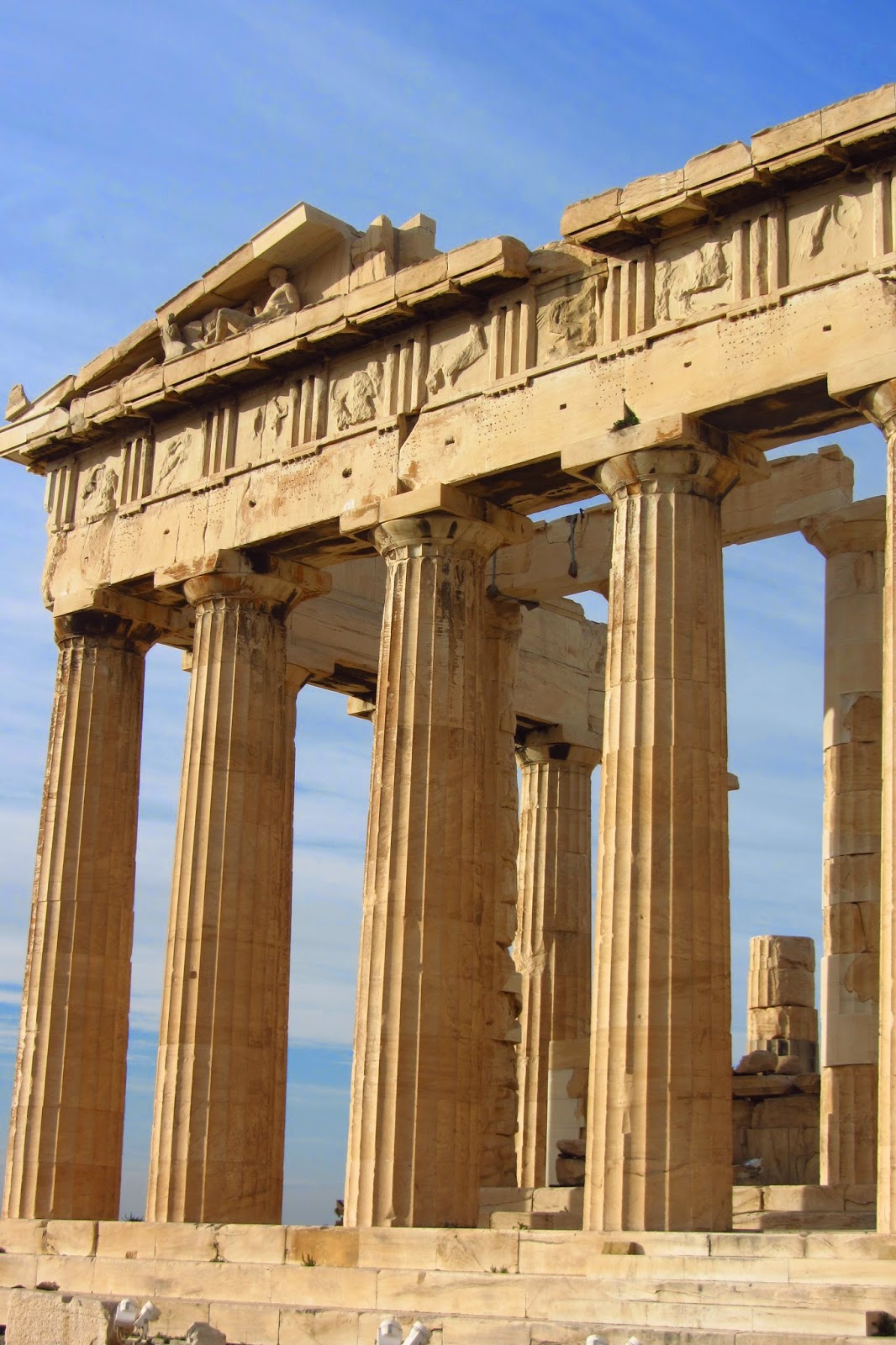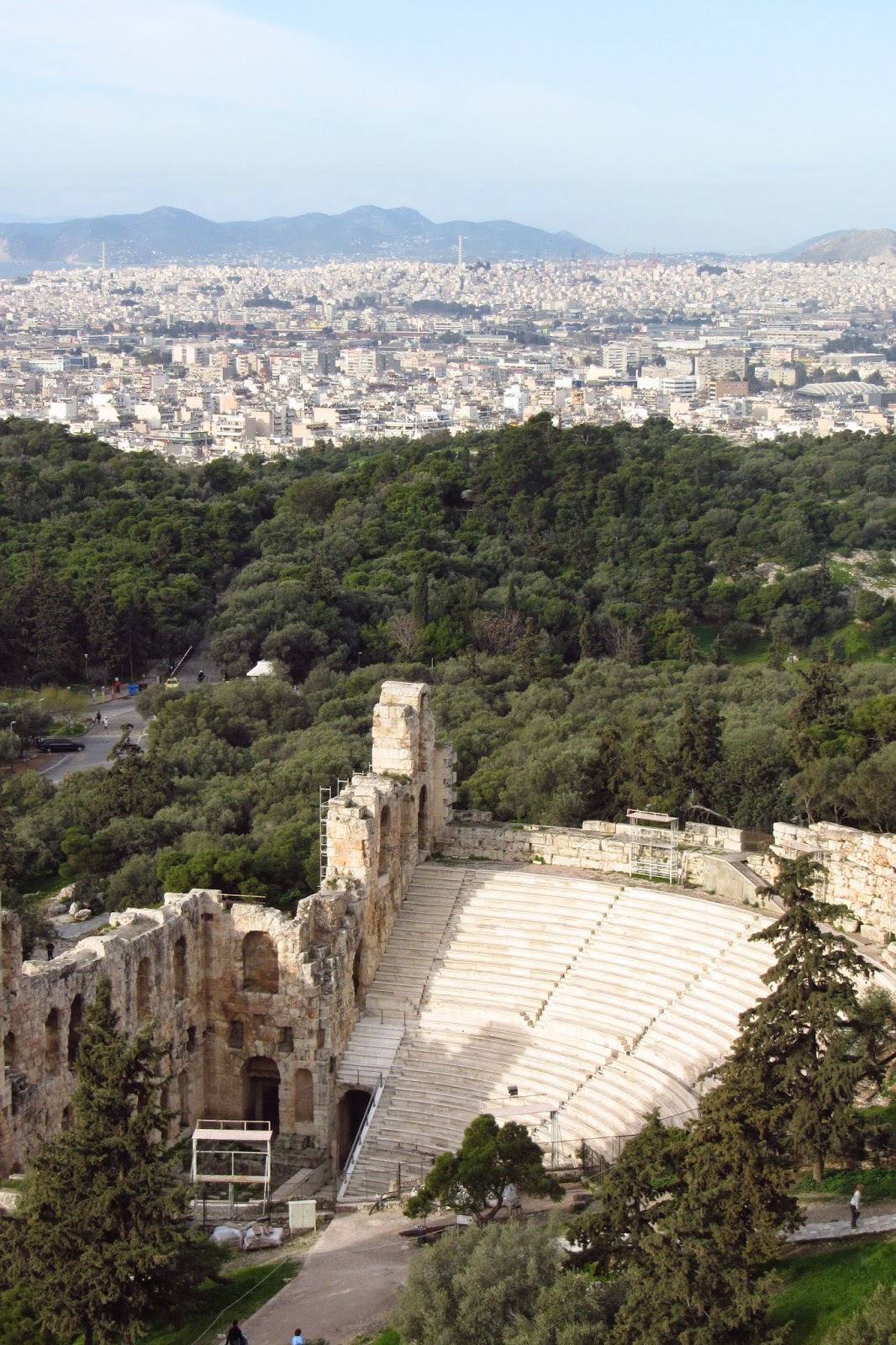Há poucos sítios assim, onde se
caminha entre prédios modernos e abraça-se, sem querer, uma coluna com milhares
de anos; ou onde se vislumbra o centro de uma cidade antiga a partir do terraço
de um moderno e vistoso hotel. Em Atenas, o berço da Antiguidade, é assim; dois
mundos diferentes, de tempos distantes, que se envolvem em discreta harmonia.
Uma mudança tranquila, sob o olhar da deusa
Quando entrei no avião, imaginava
que poderia encontrar o caos. O governo acabara de ser eleito e estava em braço-de-ferro
com a União Europeia, num país onde mais de um quarto da população está
desempregada e que passa por uma séria crise económica. Chegada à cidade, ali
onde a filosofia nasceu e a democracia germinou, na realidade sinto paz. Aquela
que vem da gente que sabe para o que vive e que se ajusta ao que tiver que ser,
com mais ou menos desembaraço.
 |
| O templo de Zeus, de noite The temple of Zeus, at night |
Satisfeita pela tranquilidade que me invade, vislumbro em frente ao Hotel no centro da cidade o que resta do Templo de Zeus, um conjunto incompleto de colunas arredondadas dispersas por um relvado, rodeado por um casario branco e denso que se alonga até às montanhas. Noto a desenvoltura com que os gregos conciliam as mudanças trazidas pelos ventos históricos, juntando o antigo ao moderno sem preconceitos.
 |
| O templo de Zeus, visto de dia, a partir do hotel The temple of Zeus, seen at daylight from the hotel |
Os monumentos milenares – ou o que resta deles, espalham-se por uma metrópole perfeitamente funcional, com uma rede de metro nova e bonita – herança dos Olímpicos de 2004, negócios variados a ladear as ruas, uma extensão de casas periféricas a perder de vista e pessoas num frenesim tipicamente urbano. A cidade de Atenas cresceu sem se soltar das raízes. Também não podia, com a vigilância constante da Acrópole que a observa do topo do monte. A luz intensa que emana do Pártenon faz-me acreditar que a adorada deusa Atenas continua a velar pela cidade e pelos gregos, agora contentes por esta renovação política mas mesmo assim ansiosos pelo possível desfecho. Ioanna, uma bela e simpática grega, diz que está satisfeita com a mudança mas desconfia do resultado. Tem que se esperar para ver! Entretanto, ao mesmo tempo que tinha esta conversa, um grupo de cidadãos juntava-se na Praça Syntagma, o centro político de Atenas, para demonstrar o seu apoio ao novo governo, em luta por um novo plano de crédito da odiada Troika. Passada mais de uma semana, este capítulo ainda não foi encerrado, mas espero que aquela serenidade, mesmo em plena desordem, se mantenha.
 |
| A Acrópole (Cidade Alta) The Acropolis (High City) |
A vida em ruínas
Para quem a visita o encantamento ainda resulta. Há 2500 anos que o vento sopra entre as colunas do templo dedicado a Atenas. Já foi mesquita e igreja católica, já ardeu e desabou, e já voltou a ser templo, espiando a cidade que muda aos seus pés. A persistência é uma qualidade admirável, e só por isso vale a pena caminhar no complexo da Acrópole, tocar as suas colunas desbotadas, pisar as muitas pedras gastas e surpreender-se com os braços das estátuas que ainda perduram. Visto de perto, no entanto, parece que o Pártenon mal se aguenta em pé. Há partes da estrutura que desapareceram completamente, os andaimes de ferro proliferam, as máquinas modernas ocupam o espaço que deveria pertencer à História. Mais ruína do que esperava, o Pártenon surgiu-me com uma técnica de renovação no mínimo surpreendente: mármore (assim parece) encaixado em calcário antigo, a brancura plena em contraste com o castanho usado. Parece estranho, como se roubassem, pedra a pedra, a origem mística do templo e o seu carácter. Bem sei que não devia ser tão exigente com monumentos desta antiguidade, que sofreram inúmeras atrocidades por esses milénios fora, mas não consigo resistir a esta mágoa que me invade.
Apesar desta sensação inesperada, o fascínio pelas ruínas é infindável. Do lado sul da Acrópole, observo o Teatro de Dionísio, dedicado ao deus do vinho, e imagino as bancadas de pedra em meia-lua repletas de gente, de taça de vinho na mão, a assistir a uma tragédia. Em frente ao Pártenon, ergue-se um pequeno templo chamado Erecteion, sustentado pelas “moças de Karyai” (cariátides) eternizadas em estátuas de dimensão humana. Da vertente norte da Acrópole, por entre as estátuas das moças (agora cópias fiéis) e as colunas resistentes, espreito os recantos da cidade, que se estende como um manto branco até às encostas das serras.  |
| Pormenor da reconstrução do Pártenon Detail of Parthenon's reconstruction |
 |
| Vista parcial do Pártenon Partial view of the Parthenon |
 |
| As "moças de Karyai" que sustentam o Erecteion The "maids of Karyai" which sustain the Erecteion |
 |
| O Teatro de Dionísio The Theatre of Dionysius |
Do lado do Propileu, a entrada monumental da Acrópole, avisto lá em baixo o templo de Hefesto, o deus grego do fogo. Parece intacto, por entre os arbustos que o acompanham. Na realidade, é o templo mais bem conservado de todo o complexo e, apesar de menos conhecido, é simplesmente grandioso! E enquanto estas estruturas antigas, aninhadas aos edifícios modernos e às casas brancas que cobrem o solo, me vão contando a sua história, a cidade vai-se estendendo até às montanhas, de um lado, e até ao mar, do outro, até ao porto de Pireus. Ali onde, mais uma vez, os contrastes se tocam, a terra e o mar abraçam-se, sem preconceito. Uma qualidade extremamente
valiosa que espero que a Grécia consiga manter sempre.
 |
| O templo de Hefesto The temple of Hephaestus |

 |
| Panoramas da cidade de Atenas, a partir da Acrópole Views of the city of Athens, seen from the Acropolis |
 |
| Atenas, a terra e o mar, o antigo e o moderno Athens, the land and the sea, the ancient and the modern |
Where the modern goes hand-in-hand with antiquity
There are few places like that, where you walk
between modern buildings and, unintentionally, you can touch a column with
thousands of years; or where you can observe the center of an ancient city from
the terrace of a modern and flashy hotel. In Athens, the cradle of Antiquity,
it is so; two different worlds, from distant times, which engage in discreet
harmony.
A peaceful change, under the eye of the goddess
When I got on the plane, I thought I could find
chaos. The Government had just been elected and was wrestling with the European
Union, in a country where over a quarter of the population is unemployed and is
going through a serious economic crisis. However, as I arrived in the city,
where philosophy was born and democracy flourished, I actually felt peace. That
sense of peace that comes from meeting people who know what they live for and
that adjust themselves to whatever comes.
Satisfied by the tranquility that invades me, I
look outside the hotel located in the center of the city, and have a glimpse of
what is left of the Temple of Zeus, an incomplete set of rounded-shaped columns
dispersed through grass, surrounded by a white and dense blanket of houses
which stretch until the mountains. I notice the agility of the Greeks in
conciliating the changes brought by historical winds, joining the ancient with
the modern without any prejudice. The millenary monuments – or what is left of
them, are spread in a perfectly functional metropolis, with a new and beautiful
metro network – an inheritance of the 2004 Olympics, several types of businesses
flanking the streets, an extensive periphery of houses and people with the
typically urban frenzy.
The city of Athens grew without losing its roots. Well,
it couldn’t anyway, as it is under the endless vigilance of the Acropolis which
observes it from the top of the hill. The intense light released by the
Parthenon makes me believe that the adored goddess Athens keeps watching over the
city and the Greeks, now happy for this political renovation but still anxious
with the possible outcomes. Ioanna, a beautiful and friendly Greek, says she is
pleased with the change but suspicious of the results. We have to wait and see!
Meanwhile, at the same time of this conversation, a group of citizens was
gathering at Syntagma square, the political center of Athens, to demonstrate
their support to the new government, who is fighting with the despised Troika
for a new credit plan. Over a week later, this chapter was not yet concluded,
but I hope that this calmness, even in disorderly times, can be kept.
The life in ruins
For the visitors the charm still works. For
2500 years the wind has been blowing amidst the columns of the temple dedicated
to the goddess Athens. It has been a mosque and a catholic church, it has been
burnt and it has collapsed, until it became a temple again, spying on the city
which changes at its feet. Persistence is an admirable quality, and just for
that reason it is totally worth it to walk through the complex of the
Acropolis, to touch its faded-colored pillars, to step on the many used rocks
and get surprised with the arms of the statues that still remain.
Seen from up
close, however, it seems that the Parthenon can barely stand. There are parts
of its structure missing, the iron-made scaffolds proliferate, modern machines
occupy the space that should belong to History. More in ruins than I expected,
the Parthenon appeared to me with a surprising renovation technique: marble (so
it looks) encased in old limestone, the pure whiteness contrasting with the old
brownish. It looks strange, as if they were stealing, stone by stone, the
mystical origin of the temple and its character. I know that I shouldn’t be so
demanding with antique monuments like this one, which suffered innumerous
atrocities throughout millennia, but I just can’t resist to this sad feeling
that invades me.
Albeit this unexpected feeling, the fascination
for the ruins is infinite. On the southern side of the Acropolis, I see the
Theater of Dionysius, the god of the wine, and can perfectly imagine the
half-moon stoned seats crowded with people watching a tragedy, with a goblet of
wine in their hands. In front of the Parthenon, it rises a small temple called Erecteion,
sustained by the “maids of Karyai” (caryatides), made eternal by the statues of
human dimension. From the north side of the Acropolis, among the statues of the
maids (now realistic copies) and the remaining columns, I peek at the city,
spreading as a white mantle until the slopes of the mountains. On the side of
the Propylaeum, the monumental gateway to the Acropolis, I can see further down
the temple of Hephaestus, devoted to the god of fire. It looks intact, amidst
the bushes that involve it. In fact, it is the most well preserved temple of
the entire complex and, despite less famous, it is simply magnificent!
While these ancient structures, entangled in
the modern buildings and the white houses that cover the ground, are telling me
their stories, the city keeps stretching to the mountains, on one side, and to
the sea on the other, until the port of Piraeus. There where, once more,
different sides touch and land and sea are embraced without prejudice. A highly
valuable quality that I hope Greece can keep forever.




